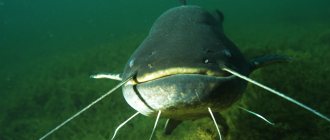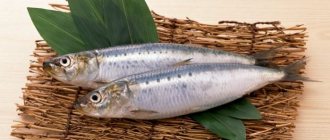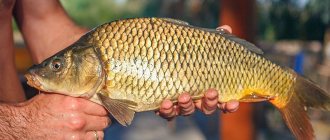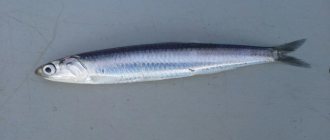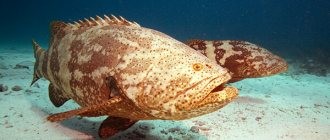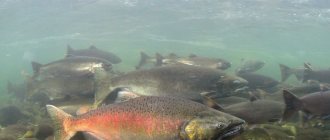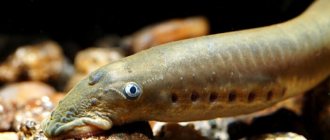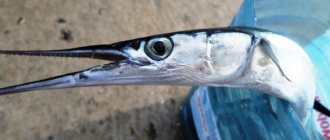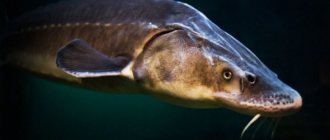Despite the fact that tench cannot be called rare, it is difficult to catch. This can only be done if you thoroughly study the habits and lifestyle of this mysterious fish. Anyone who manages to catch this hermit will receive a healthy and tasty delicacy on his table.
| Class | Ray-finned |
| Squad | Carp-like |
| Family | Carp |
| Genus | Tinca (sole representative) |
| View | Tench |
| Security status | Listed in the Red Book: -Germany -Irkutsk region -Yaroslavl region -Republic of Buryatia |
| The average size | From 20 to 70cm, up to 7.5kg. |
| Lifespan | Up to 16 years old |
| What does it eat? | Bottom invertebrates (insect larvae, worms, mollusks), aquatic plants, detritus |
| Optimal feeding time | Evening |
| Enemies | Burbot |
| What do they bite on? | On an earthworm |
Where is tench found in Russia?
Tench is a fairly common fish. Its habitat is the European part of Russia. On the Asian part, beyond the Urals, tench is less common. The border of the continuous habitat of this fish runs along the course of the Yenisei. Since this representative of carp species is dependent on environmental factors, it is practically not found in eastern Siberia and Lake Baikal.
If there is standing water in a reservoir, overgrown banks and a muddy bottom, then most likely there is tench there. Prefers moderately warm water temperatures, avoiding cold springs and rapids. Thus, well-warmed small lakes, ponds, creeks, and river channels with a quiet flow are the most favorite places for tench.
Tench usually stays near high steep banks overgrown with reeds and algae, hiding between snags and mud. Excellent tolerance to low oxygen content in water. It never migrates, preferring a solitary, measured lifestyle in familiar places. With the onset of winter, it buries itself in the silt and falls into suspended animation until the arrival of spring warmth.
Habitats
On the territory of our country, tench are registered throughout its entire part, having partially mastered the Asian expanses. Tench is thermophilic, for this reason it has chosen the basins of the Caspian, Black, Baltic, and Azov Seas. Its habitat occupies the space from the reservoirs of the Urals to Lake Baikal. Tench can also be found in such cold rivers as the Angara, Yenisei and Ob. In Europe and Asian latitudes with temperate climates, it prefers to settle in stagnant waters.
Each fish chooses a special place of residence, the most comfortable one. For tench, such places are reservoirs where the water is especially warm and clean. The bottom should be silty, silty-clayey, with abundant underwater, semi-aquatic vegetation. Tench especially loves reservoirs overgrown with water capsule, pondweed, horsetail, cattails, and reeds. This fish can be found in the overgrown channels of lowland rivers, in their bays and estuaries.
Up
General description and characteristics
Despite the fact that tench belongs to the carp family, it is not at all similar to carp. Rather, it can be confused with ide, which has a similar body structure, but lighter scales, devoid of mucus.
What does tench look like? The fish has a golden-olive color on the sides, turning into dark green or black toward the back. The abdomen has a grayish-yellow tint, and the fins are always dark. The body of the fish is covered with a thick layer of mucus, which quickly coagulates and peels off when exposed to air.
Important!
If the fish lives in a transparent reservoir with a sandy bottom, then its color becomes light golden. Living in a lake or river with a muddy or peat bottom, tench acquires a dark or even black body color.
Like all representatives of the carp family, the head of the tench is small, and the gill slits have 20 rakers. The eyes are red and small in size. The mouth is small, slightly turned up. The lips are fleshy. It has one row of teeth, the teeth at the ends are curved inward. On the jaws there are small, extremely sensitive antennae that compensate for the fish’s poor eyesight.
The tench's scales are small, very close to the body. The tail is wide with a slight truncation. The wide back fin, as well as the short tail fin, have a rounded shape, without a notch. The tench's pelvic fins tend to grow throughout their lives. The older the individual, the longer they are and can reach the anal fin. (photo).
Biting and fishing
This type of fish is usually wary of bait, but there are periods of excessive activity and the fishing is fast. The bite is reminiscent of crucian carp, with the difference that tench likes to “delay the process” for several minutes: first, he carefully plucks the bait, throwing its particles to the bottom. This can be seen by the long oscillations of the float, which fishermen often confuse with biting small fish. There is no need to hook at such moments - this is done when the float sharply deepens and begins to float to the side or lies on one side.
Disappearances are rare, since usually the hook completely cuts through the mouth. The caught fish will splash for a long time, trying to go into the silt or thickets. Therefore, when fishing, you should be persistent, and if the tench does enter the thickets, you need to pull the line a little and wait until he decides to come out of his hiding place. When the tench gets tired, it is carefully brought to the surface of the water near the shore, not allowing it to splash - this can scare away other individuals hiding nearby.
When fishing, you should not rush to hook, especially if large baits are used. Tench has a good sense of smell and touch, which helps it in searching for food and quickly finding bait. They remove the fish from the water using a net so that it does not slip out due to the mucus covering the body.
What do tench feed on?
Tench is one of those fish that prefer to get their food in the evenings. With the onset of dusk, the tench begins to actively dig the bottom in search of food. Everything is eaten: swimming beetles, leeches, mosquito larvae, insects flying above the surface of the water. Tench does not disdain grass and mud. Organic remains of invertebrate animals - detritus - are also used as food.
When night falls and the water in the reservoir gradually cools, the activity of the fish decreases sharply. Then the tench falls into a state of rest, settling in secluded places on the muddy bottom or among snags.
Important!
Tench is one of the most peaceful fish. But if the reservoir where it lives is not rich in nutrients, then the tench can exhibit predatory tendencies, eating the young of other representatives of the carp family.
Lures
Fishermen know that summer is the best time to catch tench; during this period the fish are most active. You can’t take tench with your bare hands; you need to prepare high-quality bait for it. There is no point in being lazy and saving money; the result depends on the bait.
Lure for the beginning of the season:
- Bloodworm.
- Caddisfly.
- Leeches.
- Maggot.
- Worm.
At the beginning of the season, tench prefer animal food. Then his tastes change.
Late season bait:
- Shoots of pondweed, egg capsule, reed.
- Pearl barley.
- Peas.
- Dough.
Experienced fishermen always add cottage cheese to the bait, since tench are partial to the taste and smell of this dairy product.
Tench loves to travel around its pond; it is quite possible to prepare a special feeding area for it. This will take several days. As bait, fishermen use porridge from the cereals listed above, flavoring them with cottage cheese. Those fishermen who have studied the “tench path” do not require any bait.
Up
Reproduction process
The ability to spawn in tench occurs at 3-4 years. One of the conditions for the start of spawning is water heated to 17-190C. Typically, spawning begins at the end of May and lasts for eight weeks. During this period, tench break their usual solitary lifestyle, gathering in groups.
For spawning, females prefer spawning grounds with clean, weakly flowing water. The depth, however, does not exceed 1 m. This process lasts 2-3 times at equal time intervals. Depending on the age of the fish, the number of eggs can vary from 50 to 600. The larvae attach to the roots and stems of underwater plants.
Tench caviar is very small and has a light green tint. If the water is heated to more than 200C, then the incubation period lasts no more than 4 days. Then the larvae appear and a long period of development begins. After hatching, the fry gather in small flocks. The food supply for the growing juveniles is plankton and algae.
This is interesting!
Tench is a slow growing fish. During the first year of life, the fry can grow up to 5 cm. It takes 5 years for the tench to reach a length of 20 cm.
Fish farming for sale
Due to the low stocking density, breeding tench is not the best business idea, but it can be used as an additional source of income or a hobby.
First, you need to either rent a lake from the state, or build a small pond yourself, taking into account the following requirements: clay soil and high groundwater. In any case, you will need to obtain special permission. Tench can be bred for sale or for organizing paid fishing.
To start a project, there are 2 options: put 1 adult female and 2-3 males into a small pond, or buy fry. At first, the fry will weigh 35–40 grams, but by the end of the second year, if there is a good food supply, they will gain weight up to 200 grams, and after three years - 400 grams. Moreover, you first need to release 1 fry, and after it takes root, release others.
Baby tench grows very slowly
Due to the large amount of eggs laid by the female and the low landing of the fish, it is necessary to catch fingerlings - grown fry up to a year old - and sell them. For 50 sq. meters of the pond there should be no more than 500 fingerlings - otherwise there will not be enough space and food for all of them.
Adults are fed grain waste and fish feed, and fingerlings are fed worms, grass seeds, ground potatoes, etc.
THIS IS INTERESTING! Tench takes root well in the same body of water along with crucian carp, carp and silver carp - this should be taken into account when considering the possibility of organizing paid fishing on the pond. Tench is a lazy fish that lives closer to the bottom, so other fish species will compensate for this.
It is difficult to calculate the profitability of a business, since it depends on the purpose, conditions of keeping the fish, etc.
Varieties of tench
- River. Unlike the lake one, it has a smaller build. The mouth is more pronouncedly turned upward. The color is darker. Usually avoids places with intense currents, hiding in quiet bays;
- Ozerny. The largest among his fellow tribesmen. It has a light golden body color and a silver belly;
- Pond. This tench is slightly smaller than the lake tench. Feels great in artificially created reservoirs and small natural ponds;
- Golden. A decorative variety that appeared as a result of the work of breeders. Has a golden color. There are clearly visible spots on the sides. Eyes are dark in color.
Interesting Facts
Tench breeds
Photo 5. Golden tench is an ornamental breed (orange form).
At one time, in Central Europe, selection work was carried out on tench, as a result of which its decorative breed was developed - golden tench . It differs from natural forms by the intense color of yellow or red, less often orange, as well as by eyes with a dark iris. Some of the individuals of this breed may have a pattern of small black spots. Golden tench are kept in aquariums, outdoor decorative ponds, and are also released into the reservoirs of fish farms. This breed is distinguished by the same unpretentiousness as its natural ancestor.
In addition to the golden tench, another breed was developed that is externally similar to the ordinary tench, but differs from it in its accelerated growth rate - the Kwolsdorf tench . Two-year-olds of this breed weigh from 100 to 170 grams - natural forms of tench never reach such a weight at this age.
Compared to other domestic fish breeds, the artificial maintenance and breeding of tench is more labor-intensive, therefore, as the main object of cultivation, it was not previously popular in pond farms - unlike the same carp and crucian carp. Usually tench were kept as “extra fish” along with them. Only recently has there been a tendency to specifically raise tench, thanks to the emergence of new breeds and the use of scientific methods.
Tench coexists quite well with other fish; there is also an opinion that its presence in the pond has a beneficial effect on the health of other inhabitants - due to the antiseptic and antimicrobial properties of its mucus.
Enemies of tench
The solitary lifestyle of this fish does not imply the presence of any significant threats from other inhabitants of the reservoir. For some reason, predators like pike and perch do not prey on tench. This may be due to the fact that the mucus that covers the fish disgusts them.
Burbot, which, like tench, is a bottom-dwelling fish and prefers to feed during evening twilight, is the only significant threat to tench. Competition for food, as well as the fact that burbot is not averse to feasting on the young shoots of molts, forces the tench to avoid its habitat.
A significant danger to tench is posed by poachers, who can completely destroy the population of this fish in a reservoir.
Important!
Unlike adult tench, its eggs often become prey for other aquatic inhabitants, since the spawning area is not protected by parents. Despite the fact that the number of eggs laid can be quite large, a small part of it survives to become an adult fish.
Fishing – fishing season. Fishing tackle
Tench fishing season
Most anglers catch this fish with a float rod. Firstly, because a lazy and weak tench bites inexpressively and very sluggishly, moreover, it takes a painfully long time; with bottom tackle, its bite may not be noticed. Secondly, during the fishing season it is always in the thickets, and at a shallow depth (maximum 1.5-2.0 m).
The tench fishing season begins in mid-March - early April, after the spring melting of ice. As soon as clearings appear near the shores and mouths of flowing rivers, the hermit, hungry during the winter, is already grazing near them - looking for food: caddis flies, mayfly larvae, amphipod crustaceans and breathing oxygen, which he lacked throughout winter hibernation.
At this time, he is one of the first to leave the winter quarters and begins to feed diligently. Typically, this behavior is observed in fish after spawning, during the post-spawning feeding period. Therefore, many fishermen mistakenly believe that our “teddy hero” spawns one of the first - in early spring.
At this time of year - after the ice has melted, in small, shallow ponds and lakes in which the water warms up very quickly, tench bite greedily in a way that is not typical for them. But he considers the best time to catch our handsome fish to be the beginning of summer - before and after the fish spawn. In hot weather, which usually lasts from mid-July to the end of August, it stops pecking, resuming activity only by the beginning of September.
Tackle for tench fishing
No special art is required in tench fishing; the main thing is to have patience and endurance, and not to rush into premature hooking. Ln. bites for a very long time and can unbalance anyone. If he fumbles with the bait, he will let go and repeat this many times, in fishing slang – “breaks the float”, not daring to take the bait thoroughly.
To catch tench, you can use coarse tackle, given that it will have to be pulled out of the thickets. The main line used is 0.30-0.35 mm; leads 0.20-0.25 mm; hooks 5-7 No. RN. It is recommended to use a sensitive float, not very heavy, no more than 6-7 g, a medium power rod, you can use an inertial or non-inertial reel, it doesn’t really matter. The main thing is that the fishing line matches the test of the rod on it.
Diseases
Thanks to the unique chemical composition of mucus, which abundantly covers the entire body, tench is resistant to most diseases that affect the carp family. Diseases such as dactylogyrosis, rubella and other parasites are not scary for him. However, tench can be infected with opisthorchiasis.
Unfortunately, it is impossible to determine infection in fish by eye, so before eating you should resort to one of the following measures:
- deep freeze;
- pickling;
- heat treatment.
Features of cooking tench - step-by-step recipes
There are many recipes that allow you to cook tench deliciously. Below you can find proven recipes.
Fried tench
Using this recipe, everyone can cook delicious fish, the meat of which will be fatty and slightly sweet. Before you start preparing this dish, you should take care of preparing the following ingredients:
- tench fish – 700 g (4-5 pcs.);
- salt/black pepper - to taste;
- lemon juice – 2 tbsp;
- wheat flour – 4 tbsp;
- vegetable oil – 80-100 ml.
Cooking process:
- The tench is cleaned of scales and the entrails are removed.
- The fish is thoroughly washed under cold running water.
- The tench is transferred to a deep container, salt and pepper are added to taste, as well as lemon juice.
- The marinade is evenly distributed over the carcass and the fish is left for 20 minutes.
- After the specified period of time, the tench is rolled in wheat flour on both sides and placed in a preheated frying pan with vegetable oil.
- Fry the fish for 4 minutes on each side over medium heat.
Fried tench is ready! Can be served at the dinner table with a side dish or vegetable salad.
Boiled tench - recipe
Boiled tench meat is soft, tender and very juicy.
To prepare the dish, you will need to prepare the following ingredients:
- tench fillet – 800 g (3-5 pcs.);
- onion – 400 g;
- white wine – 100 ml;
- carrots – 200 g;
- lemon – 1 pc.;
- parsley – 100 g;
- salt/black pepper/bay leaf - to taste;
- vegetable oil.
Cooking process:
- Pour water into a deep saucepan, put it on the fire and bring to a boil.
- Peel the onions and carrots, chop the parsley.
- Carrots are cut into small cubes.
- After the water boils, put onions, chopped carrots, parsley, and a small amount of vegetable oil into the pan.
- After a few minutes, add some salt to the broth, add pepper and bay leaf to taste, as well as wine. Cover the pan with a lid and leave to simmer over low heat for 60-80 minutes.
- After this, add water to the pan, bring it to a boil and lay out the tench fillet, lemon cut into thin slices.
- Cover the pan with a lid and boil the fish for about 30-40 minutes over low heat.
It is recommended to serve boiled fish with sauce.
Braised tench
Even a novice cook can prepare delicious stewed fish. To do this, you will need to take care of purchasing the necessary ingredients, namely:
- fresh tench – 1 kg;
- sour cream/mayonnaise – 250 ml;
- vegetable oil;
- wheat flour – 150-200 g;
- garlic - 1 head;
- dill – 150 g.
Also add salt/pepper/bay leaf to taste.
Cooking process:
- The fish is cleaned of scales, the insides are removed and washed thoroughly. You should get rid of not only heads and tails, but also fins.
- Cut the fish into portions and add salt/pepper to taste.
- Place mayonnaise or sour cream, chopped dill, garlic, salt and pepper to taste in a deep container. The ingredients are mixed. The sauce is ready.
- The tench is rolled in flour and fried in a frying pan (2-3 minutes on each side).
- Pour the sauce into the frying pan, turn the heat to low and simmer the fish for 15 minutes, not forgetting to add a little bay leaf to the tench.
Advice! If the gravy is too thick, you can add a little water.
Stewed tench with potatoes
Tench on the grill - recipe
If you wish, you can cook your catch right in nature. The aroma from tench on the grill will be amazing, and the appearance will be very appetizing.
To prepare you will need:
- tench – 600-800 g;
- several large onions;
- head of garlic;
- cilantro;
- vegetable oil;
- salt/pepper/spices - to taste;
- dill;
- lemon.
Cooking process:
- Cleaned and washed fish is wiped with a paper towel.
- Transverse cuts are made on the carcasses so that the marinade penetrates as deeply as possible and makes the tench meat juicy and piquant in taste.
- Garlic and onion are peeled, washed and cut into small cubes.
- Cilantro is also chopped and added to onions and garlic. Add vegetable oil, salt/pepper/spices to taste to the ingredients. The composition is mixed.
- The resulting marinade is poured over the fish, evenly distributing the composition over the surface of each carcass. The fish is left for 30-40 minutes.
- Meanwhile, the grill is heated and after the specified period of time, the marinated tench is fried on the grill over medium heat (5 minutes on each side). It is very important not to overdry it.
The finished fish is served with vegetable salad.
Catching tench is an interesting and fairly simple process if you know the basic habits of a sloth.
Even a novice fisherman, having familiarized himself with the advice and recommendations of experts, will not be left without a catch.
However, when going fishing, it is worth remembering that in winter the fish go into hibernation, and in the summer months you need to go to the reservoir early in the morning or closer to sunset, because in the heat the tench is unlikely to respond to any bait. No tail, no scales!
The benefits of meat
Freshwater tench meat is considered dietary, as per 100g. accounts for only 45 kcal. Nutritionists advise regularly eating this fish for people with high blood cholesterol and those who have diseases of the cardiovascular system.
Tench meat contains a number of important microelements: potassium, magnesium, sodium, copper, zinc, fluorine, chromium, manganese. Fish contains vitamins A, E, C. The high protein content allows tench meat to be included in the diet of children and athletes. Iodine, which fish meat is rich in, has a beneficial effect on the functioning of the thyroid gland.
This is interesting!
In Rus', it was believed that tench could cure jaundice, and healers treated wounds by applying a fish carcass cut in half to them.
Composition and nutrients
The chemical composition of meat does not differ from other representatives of freshwater bodies. It contains proteins, fats, water, minerals and vitamins. This is a unique dietary product with a calorie content of 39 kcal. Thanks to this feature, fillet can be included in the diet menu. With regular consumption of such a product, you can remove excess sugar from the body and saturate it with useful substances.
Yandex.Pictures
The composition contains the following substances:
- thiamine, niacin, riboflavin, cyanocobalamin;
- fluorine;
- calcium;
- potassium;
- manganese;
- phosphorus;
- retinol;
- tocopherol;
- chromium;
- molybdenum;
- iodine;
- copper;
- sodium.
Yandex.Pictures
This product is a storehouse of phosphorus and easily digestible protein. It also contains essential amino acids. If a person has problems with the functioning of the digestive system, you can eat tench meat instead of red fish. Fish dishes are beneficial for the body in case of heart and vascular diseases. According to the recommendations of cardiologists, such a product must be included in the weekly menu for the prevention of atherosclerosis, thrombosis and other pathologies. Thanks to iodine, the functioning of the thyroid gland improves.
Since these are dietary dishes, they are useful for those who suffer from diabetes and obesity. This is an important product for children's menus, since children need a lot of protein and protein for active growth and development. It will also be useful for those who engage in professional sports, since it also helps to gain muscle mass. Thanks to fluorine, phosphorus and calcium, the condition of the skeletal system and teeth improves. B vitamins and tocopherol benefit the skin and improve the condition of hair and nail plates. And retinol helps maintain quality vision and liver health.
Yandex.Pictures
Tench fishing
To catch this mysterious inhabitant of rivers and lakes, you need to work hard. First of all, you need to understand where, most likely, he can hide. You should look for thickets of reeds, quiet creeks with a slow current, and a muddy bottom.
Typically, the molt feeds at a depth of 0.5 to 1.5 m, collecting aquatic insects, snails, mosquito larvae and dragonflies. This means that the gear needs to be cast closer to the shore. A 4-5 meter rod is quite suitable.
Tench is a shy and cautious fish, which means that in order not to frighten it away, you need to remain quiet. After the first tench is caught, it makes sense to spend some time so that the other fish calm down and, at the same time, provide additional feeding.
Gear for catching this suspicious and timid aquatic inhabitant should not be rough or massive. The best choice is a durable fly float rod equipped with a strong fishing line of small diameter.
Appearance, size and coloring of tench
Molters lead a solitary lifestyle, being hermits by nature, they avoid other inhabitants of reservoirs that compete with them for food. They gather together, organizing small flocks, only before wintering and during spawning. Under normal living conditions and favorable circumstances, they can live a long time - up to 18-20 years, reaching 70 cm and 6-7 kg in weight.
Average weight Ln. in the catches of domestic fishermen range from 150 g to 700 g, larger specimens are found less frequently, and over 2.5 kg are very rare, since the species itself, which is considered small in number, continues to decline at a rapid pace. In many regions of Russia it is listed in the Red Book.
The typical color of tench, which is most often found, is greenish-olive with a golden tint on the sides, a dark green back and a light yellow belly. But it depends on the species belonging to a certain region, and taking this into account, it can vary greatly.
Different habitats - illumination of water bodies, average annual water temperature, saturation with oxygen and other chemical elements, soil composition, food supply and other factors indirectly affect the totality of skin pigments that reflect light from the surface of both these and other fish. It is they who create the color palette of fish clothing, which can vary from light golden colors to red-brown, dark bronze and even black tones. In silted ponds rich in peat and abundant vegetation, the color of Ln. much darker than those of its relatives living in clean lakes and rivers.
The tench's small red eyes, like ruby beads, shining against the background of velvet scales, give its appearance an unnatural, doll-like appearance. Its small mouth is framed by very fleshy lips, which makes it appear slightly swollen. There are short antennae at the corners of the mouth, one on each side. They help the “red-eyed beauties” find food in bottom sediments and determine the density of the soil even in low light.
Thanks to these small processes, the tench is able to detect vibrations caused by the movement of even small food objects, such as bloodworms or water worms - its favorite food. Moreover, they are so sensitive that they detect the source emitting them from a relatively large distance - within a radius of 4-5 m. All fins of the hermit have a wide shape, strongly rounded at the edges. In females they are much larger in size, and during the spawning period they increase even more.
What is the best way to catch tench?
The best bait for molts is a common earthworm. The main condition is that the bait should be small and not cause any suspicion in cautious fish.
Important!
The place where the fish is located can be detected by characteristic bubbles rising from the bottom. Among fishermen, this phenomenon is called “line passage” or “line path”.
Reproduction and social structure
Moon Pisces live separately from each other, and unite in groups only during the mating season, which falls in the summer. Females lay 310-320 million eggs, and do this in one territory. After this, the adults leave to go about their business, and the offspring are left to their own devices from the first day. The eggs hatch into 2-2.5 mm larvae, which begin to actively feed and gain weight.
Moonfish larvaAn interesting fact: in appearance the larvae are similar to the fry of the poisonous puffer fish, which is why many underwater predators do not risk eating them.
The most favorable places for the birth of offspring are considered to be the southern territories of the Indian, Pacific and Atlantic oceans. This is where the moon fish goes to lay eggs. After the end of the mating season, individuals return to their original habitat.
Gastronomic features
Before cooking this fish, you need to get rid of the mucus. You need to rinse the carcass well under running cold water, pour boiling water over it, and rinse again. In this case, the mucus will coagulate and be easily removed. You can easily get rid of the smell of mud by soaking the fish in a saline solution.
Like all representatives of cyprinids, tench is a bony fish. Therefore, it is worth choosing specimens as large as possible. When cleaning it, you should carefully remove the gallbladder without damaging it. Otherwise, the meat will acquire an unpleasant bitterness and will be unedible.
Many tasty, dietary and, at the same time, nutritious dishes can be prepared from tench. The meat of this fish has a sweetish taste and is excellent for frying, baking in the oven, preparing aspic and fish soup.
Catching tench is an exciting activity, similar to a difficult but interesting quest. Catching this cunning and cautious loner is a great success. And a dish prepared from this fish is a real pleasure for a true gourmet.
Recipe for tench baked with potatoes and tomatoes in the oven
Oven-baked tench turns out tender and very tasty! It is suitable both for a holiday table and for dinner with the family.
Ingredients:
- tench - 2 pcs. small size;
- tomatoes - 1-2 pieces;
- potatoes - 3 pieces;
- sunflower oil;
- dill - 2 sprigs;
- spices, mayonnaise - to taste.
Cooking algorithm
- Wash the fish thoroughly, clean it, remove the entrails, and rinse the belly well. We make cross cuts on the body and rub it with salt and oil.
- We cut the tomatoes into slices and place them together with sprigs of dill inside the fish belly.
- Cut the peeled potatoes into circles.
- Grease a baking sheet with oil and, after placing the potatoes, coat them with mayonnaise. Place fish on top of potatoes.
- Place the baking sheet in a hot oven for 40 minutes at 200°C.
Tench is a very tasty fish
. Bon appetit!
Tench is a beautiful and capricious fish with tender meat. Fishing with it will appeal to those who have endurance and a quick reaction - in this case, the fisherman will get real pleasure, and the family will get fish for lunch or dinner.
Beneficial properties for the body
Onions have the following properties:
- strengthens the immune system, and the high content of vitamins improves body tone and improves health;
- thanks to folic acid, it is useful for pregnant women - it is involved in the formation of the fetus and improves mood;
- recommended for people suffering from diabetes, stimulates insulin production;
- has calming properties, improves sleep quality;
- fights fungal diseases;
- used in cosmetology – affects the condition of hair, skin and nails;
- improves metabolism, improves food digestion;
- has a diuretic effect;
- relieves swelling;
- normalizes water-salt balance;
- removes toxins and waste from the body;
- increases iron levels in the blood.
Fried onions are included in the diet by those who suffer from:
- atherosclerosis;
- kidney diseases;
- oncology;
- colds and viral diseases.
Where did rotan come from?
Rotan (aka “firebrand”) suddenly and unexpectedly began to appear in many reservoirs in Russia. Now all fishermen have heard about it, but what happened 20 years ago? Personally, I didn’t know about this fish at all. Where did this fish come from?
The homeland of rotan is the Far East, it lived there for a long time, and everything was fine, nature controlled the population of this species naturally. But then scientists from St. Petersburg appeared and saw in him the saviors of reservoirs. Initially, it was believed that rotan could eat vegetation, and given that it reproduces quickly, it can replace silver carp and grass carp.
They brought him and released him into local ponds. These scientists had no idea what they had done...
According to another version, rotan climbed into central Russia naturally. But given the vast distance, this is unlikely. The first option is more truthful.
Interesting article: Tench fish photo and description, food, where it lives
History and geography of the product
In different countries, this amazing fish goes by different names. In Latin its name sounds like Mola mola
and means millstone.
And modern Europeans, Australians and Americans know the amazing creature as the moonfish
or
sunfish
. Moreover, the fish owes such unusual names to its unusual shape, size and habits that are strange for sea inhabitants.
The largest bony fish existing today have an oval or almost round, laterally flattened, tailless body. The surface of the moonfish shimmers with silver and all shades of bronze and brown. Since the fish, growing up to four meters in length and weighing up to two tons, lives at depths of up to 1000 meters, its skin is unusually strong and elastic, and small bony outgrowths are noticeable on its surface.
The sunfish's diet consists of plankton, small fish and squid, shellfish and jellyfish. This food preference forces huge fish to rise to the surface during the daytime, and with the onset of darkness they go into the depths, hiding from numerous enemies. Despite the record size of adult individuals, the sunfish swims slowly and clumsily, and for the most part prefers to lie on its side at the surface of the water, barely noticeably moving its fins.
Even in the century before last, a meeting between sailors and a moonfish could cause serious panic on the ship. Slow and harmless fish were long considered by sailors to be a harbinger of a storm, but neither biologists nor meteorologists could confirm such prejudices. But data on the longevity of these marine fish is documented. Female sunfish can live up to 105 years, but the lifespan of males is on average twenty years less.
The fish is thermophilic and prefers to stay in layers where the temperature does not fall below 20 degrees, so you can meet the sea giant in tropical waters of the World Ocean that are warm enough for the species to live comfortably. And in some seasons, the appearance of moonfish was noted off the coast of Japan and Kamchatka, in the Mediterranean Sea and near Norway, Britain and even Iceland.
However, there is no fishing for sunfish. Moreover, in Europe it is simply prohibited. But you can find fish under this name on the shelves of many countries. The fact is that under this trade name the consumer is offered vomers
or
selenium.
Several species of these silvery-green fish with a tall, laterally compressed body live in the eastern Pacific Ocean and the Atlantic. True, unlike real sunfish, they can only grow up to 80 centimeters in length and prefer shallow water.
Seleniums are a desirable prey for sports fishermen. And only Atlantic species, in particular the Peruvian sunfish, are of serious commercial importance, although recently the population has become very sparse. Vomers are in greatest demand in the markets of Asia, Eastern Europe and Russia.
The nutritional value
Tench meat is bony, like all freshwater fish of the carp family, but has excellent taste. The taste is slightly sweet and very juicy. It often has a muddy or moldy smell; this can be eliminated by soaking in salted milk or pickling. Also, to eliminate this smell, the fish is cooked with a lot of spices. As another option (used in the past), the fish should be kept in a cage in running water for several days (at least a week), and it can be fed with bread.
Tench is superior in taste to carp and crucian carp. However, according to some fishermen, during spawning its taste noticeably deteriorates; tench should not be caught for food during this period.
Cooking features
Tench is suitable for boiled, stewed and fried dishes. In addition, it can be dried and smoked, and also made into cutlets.
How to clean a tench
Before cooking, it is necessary to wash off all the mucus from the tench. To do this, the fish is first washed under running water, then doused with boiling water. Tench mucus contains protein compounds, so high temperatures denature it - it coagulates like egg whites. After which it can be easily cleaned with a blunt knife under running water. At the same time, it makes no sense to clean off the scales, since they are very small and sit very firmly in the skin. It can be removed only after scalding the fish in boiling water for 30 seconds, or with a special grater. During heat treatment, the scales “dissolve” and merge with the skin of the tench, so they will not bother you while eating.
- Protein content: 21%.
- Fat content: 3%.
- Calorie content (per 1 kg): 895 kcal.
Batter options
For fish, you can choose a different batter if desired. Add additional ingredients to it, including spices, seasonings, herbs or something else. Batter options for fish dishes:
- cheese - grated cheese, egg, sour cream, flour, salt, spices;
- beer - beer (preferably light), flour, salt, egg yolks (the same batter is prepared with table white wine instead of beer);
- on water - mineral water, flour, egg, salt;
- with herbs - chopped spicy herbs (or dried), mayonnaise, egg, flour, salt, spices;
- garlic - fresh garlic puree, mayonnaise, egg, breadcrumbs;
- saffron - natural Imeretian saffron or turmeric, water for infusing seasoning, salt, sour cream, flour, egg yolks.
The mixture should be thick to completely envelop the pieces of product.
This is how tench fish is prepared. The recipes are not complicated, but do require plenty of pre-processing and marinating time.
Methods of catching sea lenka
Fishermen know sea lenok, which belongs to the family of greenlings. Its distribution area is the Russian Far East. It is here that you can find a sea lion, which has an elongated, laterally compressed oblong body; the color of its scales varies depending on the age of the fish and its gender. Older individuals have a rich, pronounced brownish color.
The marine variety of lenok is a medium-sized fish: on average it reaches 60 cm in length and weighs 1.5-1.6 kg. It prefers to be near the bottom in a body of water, feeding on small mollusks, worms, and bottom insects. However, it can also catch small fish.
Fishing methods
Vertical fishing is considered the most effective when catching such a marine predator. It can be caught well with both natural and artificial baits. Prefers bright and moving baits, reacts to them quickly and actively.
Silicone baits have become fashionable and have proven to be very effective. Brightly colored and practically identical to natural ones, these types of silicone baits allow you to get a rich catch of sea lion.
Catching sea lenka with a “tyrant”
This type of fishing, called “tyrant”, has been used with some variations for a long time. Its principle is to use a long cord that is wound on a reel of any shape. Initially, the use of a specific fishing rod was not envisaged. A sinker is attached to the end of the cord, the weight of which depends on the desired diving depth and the expected weight of the catch. On average, the sinker used weighs 400 g.
Leashes are attached to the cord. There are usually several of them, 10-15 pieces. Leashes are made from different materials; monofilament is considered the most practical for sea hunting; wire and metal material are also used. Sea lion is not too picky about the material and size of fishing line, so a thicker and stronger one is recommended. Anti-corrosion coating for the hook and other metal parts of the tackle is a prerequisite for maintaining the performance of the fishing rod. Indeed, due to the high salt content, sea water will quickly render them unusable.
Now the most colorful design of the end of the cord with bright materials is used:
- colored threads;
- multi-colored feathers;
- a piece of variously colored synthetic material.
To increase the interest of fish, colored spoons decorated with beads and beads can be used. A prerequisite: the use of proven, reliable and often expensive fittings. After all, the fishing result largely depends on the quality of the gear used. And since lenok is a strong fish that can resist for a long time, it is strong fittings that will prevent you from getting disappointed in the form of a torn fishing line or a broken hook.
The principle of fishing using the “tyrant” method is similar in technique to vertical lures: the sinker is lowered almost to the level of the bottom of the reservoir, then the lure can be played to attract the attention of the fish. And then the rod rises. Sometimes, for successful fishing, it is enough to lower the sinker and the game that arises as a result of the rocking of the vessel will arouse the interest of the fish.
Lures and tackle
The sea lion, being a predator, shows a special interest in natural baits. Therefore, pieces of fresh meat, insect larvae and shellfish can be called the most interesting baits for him.
However, artificial replacements for live baits also performed well. For example, brightly colored silicone imitation worms and various other options for modern baits will allow you to get a good catch of sea lion.
The vertical fishing option is considered the best, and from the shore you can try sea lenka using the “casting” method.
Fishing and habitat areas
This fish, a commercial species, lives in the waters of reservoirs in the Far East, the Yellow Sea, Sakhalin, and the Kuril Islands. Found in the coastal waters of Kamchatka and the Sea of Okhotsk.
They also catch sea lenka while walking, since its habitat is the coasts of coastal cities.
